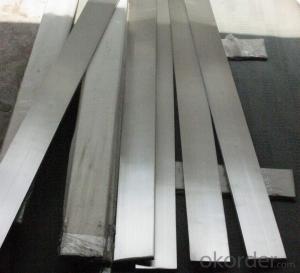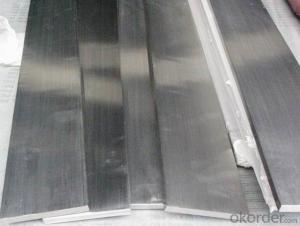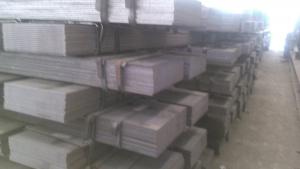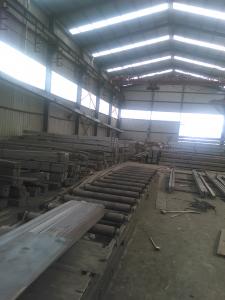Angle Steel Hot Rolled High Quality 25-250MM GB Q235
- Loading Port:
- Shanghai
- Payment Terms:
- TT or LC
- Min Order Qty:
- 25 m.t.
- Supply Capability:
- 200000 m.t./month
OKorder Service Pledge
OKorder Financial Service
You Might Also Like
Product Description:
OKorder is offering Angle Steel Hot Rolled High Quality 25-250MM GB Q235 at great prices with worldwide shipping. Our supplier is a world-class manufacturer of steel, with our products utilized the world over. OKorder annually supplies products to European, North American and Asian markets. We provide quotations within 24 hours of receiving an inquiry and guarantee competitive prices.
Product Applications:
According to the needs of different structures, Angle can compose to different force support component, and also can be the connections between components. It is widely used in various building structures and engineering structures such as roof beams, bridges, transmission towers, hoisting machinery and transport machinery, ships, industrial furnaces, reaction tower, container frame and warehouse etc
Product Advantages:
OKorder's Angle Steel Hot Rolled High Quality 25-250MM GB Q235 are durable, strong, and resist corrosion.
Main Product Features:
· Premium quality
· Prompt delivery & seaworthy packing (30 days after receiving deposit)
· Corrosion resistance
· Can be recycled and reused
· Mill test certification
· Professional Service
· Competitive pricing
Product Specifications:
Manufacture: Hot rolled
Grade: Q195 – 235
Certificates: ISO, SGS, BV, CIQ
Length: 6m – 12m, as per customer request
Packaging: Export packing, nude packing, bundled
Sizes: 25mm-250mm | ||||||||||||
a*t | ||||||||||||
25*2.5-4.0 | 70*6.0-9.0 | 130*9.0-15 | ||||||||||
30*2.5-6.6 | 75*6.0-9.0 | 140*10-14 | ||||||||||
36*3.0-5.0 | 80*5.0-10 | 150*10-20 | ||||||||||
38*2.3-6.0 | 90*7.0-10 | 160*10-16 | ||||||||||
40*3.0-5.0 | 100*6.0-12 | 175*12-15 | ||||||||||
45*4.0-6.0 | 110*8.0-10 | 180*12-18 | ||||||||||
50*4.0-6.0 | 120*6.0-15 | 200*14-25 | ||||||||||
60*4.0-8.0 | 125*8.0-14 | 250*25 | ||||||||||
FAQ:
Q1: Why buy Materials & Equipment from OKorder.com?
A1: All products offered byOKorder.com are carefully selected from China's most reliable manufacturing enterprises. Through its ISO certifications, OKorder.com adheres to the highest standards and a commitment to supply chain safety and customer satisfaction.
Q2: How do we guarantee the quality of our products?
A2: We have established an advanced quality management system which conducts strict quality tests at every step, from raw materials to the final product. At the same time, we provide extensive follow-up service assurances as required.
Q3: How soon can we receive the product after purchase?
A3: Within three days of placing an order, we will begin production. The specific shipping date is dependent upon international and government factors, but is typically 7 to 10 workdays.
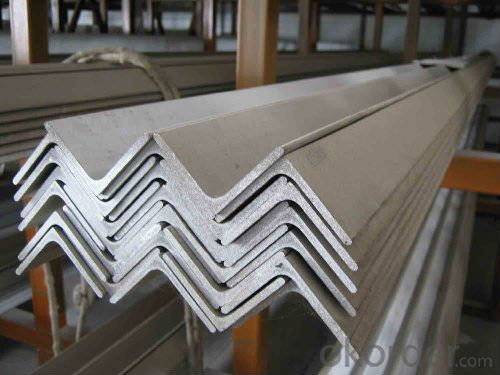
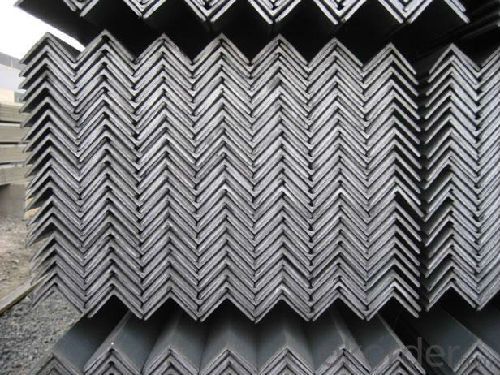
- Q:How do steel flat bars compare to ceramic flat bars?
- Different properties and characteristics distinguish steel flat bars from ceramic flat bars, making them appropriate for various applications. Known for their strength and durability, steel flat bars consist of a blend of iron and carbon, resulting in a high tensile strength. This quality renders them perfect for heavy-duty applications like construction, manufacturing, and the automotive industry. Furthermore, steel flat bars exhibit resistance to impact, minimizing the likelihood of breakage or cracking under pressure. Additionally, their malleability allows for easy welding and manipulation, enhancing their versatility. Conversely, ceramic flat bars are renowned for their resistance to heat and low friction properties. Crafted from non-metallic materials, such as clay or porcelain, these bars undergo high-temperature firing, rendering them ideal for applications requiring heat resistance, such as furnace linings or kiln furniture. Moreover, their low friction characteristics deem them suitable for applications where friction reduction is crucial, such as bearings or cutting tools. In terms of aesthetics, steel flat bars emanate a metallic and industrial appearance, while ceramic flat bars exude refinement and elegance. This visual discrepancy may influence the selection between the two types of flat bars, depending on the desired visual impact within the application. To summarize, steel flat bars are favored for their strength, durability, and versatility, making them appropriate for heavy-duty applications. Conversely, ceramic flat bars are valued for their heat resistance and low friction properties, making them ideal for applications necessitating these attributes. Ultimately, the decision between steel and ceramic flat bars hinges on the specific requirements and demands of the application at hand.
- Q:How do steel flat bars contribute to the overall stability of a structure?
- The overall stability of a structure is significantly improved with the use of steel flat bars. These bars possess exceptional tensile strength, allowing them to withstand immense forces without bending or breaking. As a result, they provide crucial structural support, preventing the structure from collapsing under heavy loads or external pressures. Furthermore, steel flat bars are commonly employed as braces or reinforcements in construction. They can be strategically positioned and welded to different sections of the structure to enhance its rigidity and prevent any potential deformations. Through the even distribution of weight, these bars play a key role in maintaining the structural integrity and preventing undesirable movements or vibrations. Additionally, steel flat bars exhibit remarkable durability and resistance to corrosion, making them ideal for long-term use in various environments. This durability ensures that the structure remains stable and secure over time, even when exposed to harsh conditions, moisture, or chemicals. Moreover, the versatility of steel flat bars allows for their application in a wide range of structural scenarios. Whether they are used for beams, columns, trusses, or as a foundation for other components, these bars provide stability and support to different parts of the structure. They can be easily customized and fabricated to meet specific design requirements, guaranteeing that the structure is constructed to withstand the intended loads and forces. In conclusion, steel flat bars are essential elements in enhancing the overall stability of a structure. Their exceptional tensile strength, resistance to deformation, durability, and versatility make them indispensable components in construction projects. By offering support, reinforcement, and resistance against external forces, these bars contribute significantly to the structural integrity and safety of the built environment as a whole.
- Q:The total floor distribution along the wall surface 40x4 galvanized flat steel, flat paint is painted yellow mark or brush a straight chute
- Fire retardant anti-corrosion coating, waterproof and anti-corrosion, and insulation effect is good, can be painted on any material, anti high temperature insulation shielding current through, corona discharge point phenomenon. Good insulation is the most basic and reliable means to ensure the safe operation of electrical equipment and lines, and to prevent the occurrence of electric shock accidents. As for what brush Road, this seems to have no mandatory requirements. Hope to adopt!
- Q:What are the common methods of surface cleaning for steel flat bars?
- Surface cleaning steel flat bars can be achieved through several common methods. These methods include: 1. Employing Mechanical Cleaning: Physical scrubbing using abrasive materials like wire brushes, sandpaper, or abrasive pads effectively removes dirt, rust, or other contaminants from the surface of steel flat bars. This method is suitable for light to moderate cleaning and can be done manually or with the assistance of power tools. 2. Utilizing Chemical Cleaning: The use of various cleaning agents or solvents dissolves and eliminates stubborn contaminants such as dirt, grease, oil, from the surface of steel flat bars. Alkaline or acidic solutions, degreasers, or specialized steel cleaners are commonly used cleaning agents. It is crucial to adhere to the manufacturer's instructions and safety guidelines when handling chemical cleaning agents. 3. Implementing Pickling: Pickling is a method typically employed to remove heavy rust or scale from the surface of steel flat bars. This method involves immersing the bars in an acidic solution, usually a mixture of hydrochloric acid and water, which effectively dissolves the rust or scale. After pickling, the bars are thoroughly rinsed to eliminate any remaining acid and then dried. 4. Utilizing Sandblasting: This method employs compressed air to propel fine abrasive particles, such as sand or steel grit, at high speeds onto the surface of steel flat bars. Sandblasting is highly effective for removing heavy rust, scale, or old paint coatings. Additionally, it creates a roughened surface that enhances adhesion for subsequent coatings or finishes. 5. Employing Electrochemical Cleaning: Electrochemical cleaning, also known as electrolysis or electrocleaning, utilizes an electric current to eliminate rust or other contaminants from the surface of steel flat bars. The bars are submerged in an electrolyte solution, and the electric current dissolves the rust, leaving a clean surface. This method is commonly used for delicate or intricate surfaces where mechanical methods may cause damage. Choosing the appropriate cleaning method is essential and should be based on the level of contamination, type of surface, and desired end result. It is crucial to follow proper safety procedures and wear personal protective equipment when conducting surface cleaning on steel flat bars.
- Q:Can steel flat bars be easily painted or coated?
- Yes, steel flat bars can be easily painted or coated. The smooth and flat surface of steel flat bars allows for easy application of paint or coatings. Prior to painting or coating, it is important to ensure that the surface is clean and free of any rust, dirt, or grease. This can be achieved by sanding the surface and using a suitable cleaner or solvent. Once the surface is properly prepared, a primer may be applied to improve adhesion and durability of the paint or coating. Finally, the desired paint or coating can be applied using a brush, roller, or spray method. It is recommended to follow the manufacturer's instructions for the specific paint or coating being used. Overall, steel flat bars provide a suitable surface for painting or coating and can be easily transformed to meet various aesthetic or protective requirements.
- Q:What are the different surface finishes available for steel flat bars?
- Steel flat bars come in a range of surface finishes, each with its own unique properties and visual appeal. 1. The hot rolled finish is the most commonly used surface finish for steel flat bars. It involves heating the steel above its recrystallization temperature and then rolling it to achieve the desired shape. This finish has a rough and scaled texture, making it suitable for applications where appearance is not the main concern. 2. The cold drawn finish, on the other hand, involves pulling the steel flat bar through a die to reduce its thickness and improve its surface finish. This results in a smooth and polished surface, making it ideal for applications that require a clean and sleek appearance. 3. For a high-gloss shine, the cold drawn bars can be further polished to achieve a bright finish. This type of surface finish is often used in decorative applications, such as handrails, furniture, and architectural elements, where a reflective and visually pleasing surface is desired. 4. To protect the steel flat bar from corrosion, a galvanized finish can be applied. This involves applying a layer of zinc to the surface, providing excellent durability and resistance to rust. It is particularly suitable for outdoor applications or environments with high moisture content. 5. Additionally, steel flat bars can be coated with different materials to enhance their appearance or provide extra protection. Common coatings include powder coating, which offers a durable and decorative finish, and epoxy coating, which increases resistance to chemicals and abrasion. Ultimately, the choice of surface finish for steel flat bars depends on the specific requirements of the application, taking into account factors such as aesthetics, corrosion resistance, and durability.
- Q:What are the different types of steel flat bar profiles?
- There are several different types of steel flat bar profiles available, each designed for specific applications and requirements. Some common types include: 1. Mild Steel Flat Bar: This is the most commonly used type of steel flat bar, known for its versatility and affordability. It is often used in construction, manufacturing, and general fabrication projects. 2. Stainless Steel Flat Bar: Stainless steel flat bars are corrosion-resistant and have high strength. They are commonly used in industries such as food processing, chemical, and marine applications where resistance to rust and corrosion is crucial. 3. Alloy Steel Flat Bar: Alloy steel flat bars are made by adding various elements such as chromium, nickel, or molybdenum to enhance their strength, hardness, and durability. They are commonly used in applications where high strength and resistance to wear and tear are required. 4. Tool Steel Flat Bar: Tool steel flat bars are specifically designed for use in cutting tools, mold-making, and other tooling applications. They possess high hardness, wear resistance, and toughness, making them suitable for machining and shaping operations. 5. Carbon Steel Flat Bar: Carbon steel flat bars contain primarily carbon as the main alloying element. They are known for their high tensile strength, excellent weldability, and affordability. Carbon steel flat bars find applications in structural components, machinery parts, and general fabrication. Each of these flat bar profiles has its own unique properties and application-specific advantages. The choice of the right type depends on factors such as the intended use, environmental conditions, and required mechanical properties.
- Q:What are the weight and load-bearing capacities of different steel flat bar sizes?
- Steel flat bars can have varying weight and load-bearing capacities depending on their size. Generally, the larger the flat bar, the greater its weight and load-bearing capacity. Below are some common sizes of steel flat bars and their approximate weight and load-bearing capacities: 1. For a thin flat bar that is 1/8 inch thick, it is typically used for lighter applications. Its weight can range from around 0.42 pounds per foot, and its load-bearing capacity is approximately 200 pounds per foot. 2. If the flat bar is slightly thicker at 1/4 inch, it can handle heavier loads. It typically weighs around 0.85 pounds per foot and has a load-bearing capacity of about 400 pounds per foot. 3. A thicker option is the 3/8 inch steel flat bar, which can support even greater loads. Its weight can range from around 1.27 pounds per foot, and its load-bearing capacity is approximately 600 pounds per foot. 4. Significantly thicker, the 1/2 inch steel flat bar is commonly used for heavy-duty applications. It weighs around 1.7 pounds per foot and has a load-bearing capacity of about 800 pounds per foot. 5. For extremely heavy loads, the 1 inch thick steel flat bar is suitable. It typically weighs around 3.4 pounds per foot and has a load-bearing capacity of approximately 1600 pounds per foot. It is important to note that these weight and load-bearing capacities are approximate and can vary based on the grade and quality of the steel used. Other factors such as the length and support conditions of the flat bar should also be considered when determining its maximum load-bearing capacity. It is advisable to consult professional engineers or refer to load tables provided by steel manufacturers for accurate and specific information on the weight and load-bearing capacities of steel flat bars.
- Q:How do steel flat bars perform in terms of thermal expansion?
- Steel flat bars exhibit a comparatively low coefficient of thermal expansion, resulting in reduced expansion and contraction compared to alternative materials in response to temperature fluctuations. Consequently, steel flat bars possess exceptional resistance to warping or distorting caused by thermal expansion. Moreover, their thermal conductivity is relatively high, facilitating efficient heat transfer. These attributes render steel flat bars the preferred option in scenarios where temperature fluctuations are anticipated, including construction, manufacturing, and engineering projects.
- Q:Can steel flat bars be used for making HVAC systems or components?
- Yes, steel flat bars can be used for making HVAC systems or components. Steel flat bars are commonly used in the construction industry due to their strength and durability. They can be used to fabricate various parts of HVAC systems such as ductwork, brackets, supports, and frames. The versatility of steel flat bars allows for customization and the ability to meet specific design requirements. Additionally, steel flat bars have excellent thermal conductivity, which is beneficial for HVAC systems as it helps in the efficient transfer of heat or cold air. Overall, steel flat bars are a suitable material choice for making HVAC systems or components.
1. Manufacturer Overview |
|
|---|---|
| Location | |
| Year Established | |
| Annual Output Value | |
| Main Markets | |
| Company Certifications | |
2. Manufacturer Certificates |
|
|---|---|
| a) Certification Name | |
| Range | |
| Reference | |
| Validity Period | |
3. Manufacturer Capability |
|
|---|---|
| a)Trade Capacity | |
| Nearest Port | |
| Export Percentage | |
| No.of Employees in Trade Department | |
| Language Spoken: | |
| b)Factory Information | |
| Factory Size: | |
| No. of Production Lines | |
| Contract Manufacturing | |
| Product Price Range | |
Send your message to us
Angle Steel Hot Rolled High Quality 25-250MM GB Q235
- Loading Port:
- Shanghai
- Payment Terms:
- TT or LC
- Min Order Qty:
- 25 m.t.
- Supply Capability:
- 200000 m.t./month
OKorder Service Pledge
OKorder Financial Service
Similar products
New products
Hot products
Related keywords
